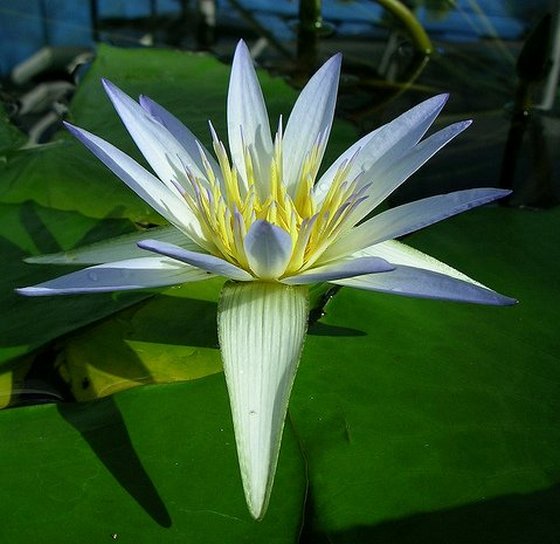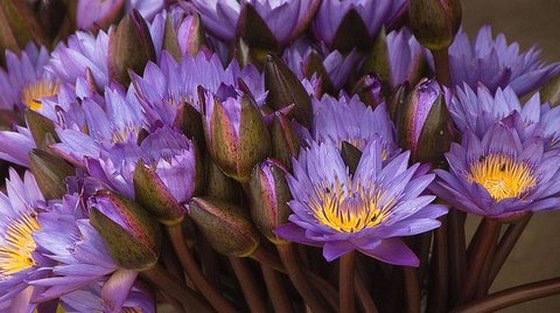
Blue Lotus Flower Meaning
Find out about the meanings of Blue Lotus Flower
The blue Lotus flower has been steeped in symbolism since the time of the Egyptians, where it was used as a metaphor for re-birth and of the Sun. It also plays a key role in Buddhism where it's color is thought to be associated with a victory of the spirit.
There are three main plant species that are referred to as the blue Lotus, and these belong to two different genera. The species are as follows: Nymphaea caerulea; Nymphaea nouchali; and Nelumbo nucifera.
All of these are also referred to as blue water lilies (amongst other names). The Nelumbo genus should not really be referred to as a water lily; plants of this name are rightly classified in the Nymphaea genus.
One of the major distinctions between the two types of lotus is that the true lotus, Nelumbo, creates a circular seed pod.
The first of these species Nymphaea caerulea is the plant that plays a major role in Egyptian culture, and although the plant is native to Egypt it is known to have spread throughout Southern and Southeastern Asia long before the prevalence of the Egyptian Empire.
In addition to their use as ornamental plants and in spirituality, which will be discussed below, the tubers and seeds of Lotus are also a well known source of food, and the plant can also be used in the treatment of ailments such as indigestion.
Blue Lotus Flower Meaning in Egytian Culture
The blue Lotus is strongly connected with Egyptian culture, and it features in many ancient paintings, and carvings. Perhaps the most well-known role of the blue Lotus flower in Egyptology is set in it’s association with the Sun, the creation, and rebirth.
The reason that that Lotus is used as a metaphor for these things is due to the way that it raises out of the water, over a small period of time, and flowers in the morning to the late afternoon, before sinking below the surface again. The repeat of this pattern makes it easy to understand why the Egyptians chose it to symbolize the Lotus with rebirth, as it followed the same pattern as the sun.

Egyptian Blue Lotus Flower (Nymphaea caerulea)
In addition to being used as a metaphor, the blue Lotus flower was also used for other things by the Egyptians, for example it was fairly often used in a herbal tincture along with wine, this is because the liquid made that Lotus tea acted as both a sweetener, and perhaps more importantly added a slight narcotic affect.
The flowers from the Lotus plant were also considered to have aphrodisiac properties. The plant is also associated with pain relief, and was thought to stimulate circulation.
It is not only the blue Lotus that is native to the Nile area, as the white Lotus was known to be growing in the region during the time of the ancient Egyptians. Furthermore, the pink lotus flower was also introduced at some stage. However, it is a blue Lotus flower that is most often seen Egyptian art.
The Lotus is known to have been abundant in the upper Egyptian area, whereas in the lower regions of Egypt, Papyrus was by far the more common plant in the waterways. Therefore the two plants are often shown entwined together as a symbolism of the bringing together of the lower and upper kingdoms of Egypt.
As the Lotus is closely associated with the sun in Egyptian mythology it comes as little surprise that the Lotus is shown as an emerging from the primordial waters carrying the Sun God.
The Blue Lotus Flower and its Symbolism in Buddhist Culture
The Lotus is a symbol of purity and enlightenment in the Buddhist culture, and different colors of Lotus are known to symbolize different aspects of spirituality. In Buddhism the blue Lotus flower is symbolic with a victory over the spirit of self, that is to say being able to leave wisdom, intelligence, and knowledge behind and becoming open to spirituality and the attachment to life.

Blue Lotus Flowers emerging in a state of purity from a murky pond.
In Buddhism, the Lotus is considered to be one of the eight auspicious symbols, and is associated with the purification of the mind and body, and the ability to blossom and become liberated.
In Buddhist art it is usually seen that the blue Lotus flower is partially open, this in itself signifies a state between full enlightenment (fully opened flower) and a closed mind (closed bud). It is the blue Lotus that is the preferred flower of Manjushri (Gentle Glory), the enlightened bodhisattva transcended wisdom.